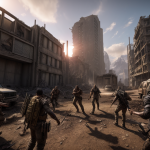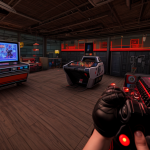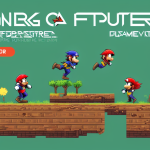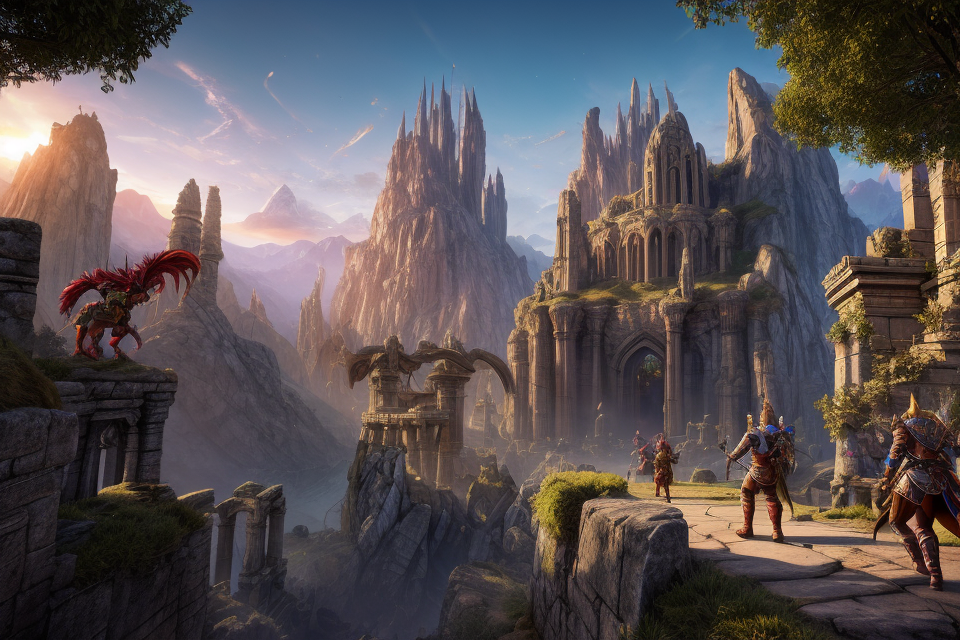Welcome, adventurers! Are you ready to embark on a thrilling journey into the world of Dungeons and Dragons? This immersive tabletop role-playing game has captured the hearts of millions, but what exactly makes it so magical? In this comprehensive guide, we’ll delve into the enchanting realm of Dungeons and Dragons, exploring its intricate mechanics and uncovering the secrets to successful combat adventures. Get ready to unleash your inner hero and discover the endless possibilities that await you in this captivating world of fantasy and imagination.
Understanding the Basics of Dungeons and Dragons
What is Dungeons and Dragons?
Dungeons and Dragons (D&D) is a tabletop role-playing game that was first published in 1974 by Gary Gygax and Dave Arneson. It has since become one of the most popular and influential games in the world, with millions of players worldwide.
At its core, D&D is a game of storytelling and imagination, where players take on the roles of fictional characters and embark on adventures in a fantasy world. The game is typically played with a group of friends, with one player acting as the Dungeon Master (DM), who guides the story and controls the non-player characters (NPCs) and monsters.
Players create their characters by choosing a race, class, and background, and then use the game’s rules to determine their abilities, skills, and statistics. They then work together with their fellow players and the DM to explore dungeons, fight monsters, and complete quests.
The game is typically played using polyhedral dice, with different types of dice representing different actions and outcomes. The DM uses these dice to determine the success or failure of the players’ actions, as well as the outcomes of their encounters with NPCs and monsters.
Overall, D&D is a game that encourages creativity, collaboration, and strategic thinking, and is a beloved pastime for many players worldwide.
The Role of the Dungeon Master
Overview
In the realm of Dungeons and Dragons, the Dungeon Master (DM) holds a vital role in shaping the overall experience for players. As the narrator, referee, and architect of the game world, the DM’s responsibilities encompass various aspects of the adventure.
Responsibilities
- Storytelling: The DM creates and narrates the story, non-player characters (NPCs), and their motivations. They craft the plot, including conflicts, challenges, and character interactions, while maintaining consistency within the game world.
- World-building: The DM designs the game world, including its geography, history, cultures, and politics. This world-building process adds depth and richness to the game, enabling players to immerse themselves in a vibrant and dynamic setting.
- Rules Arbitration: The DM interprets and enforces the rules of the game, making decisions on the fly when necessary. They ensure that players adhere to the rules and maintain fairness and balance within the game.
- NPC Management: The DM controls and portrays NPCs, assigning appropriate statistics and abilities. They also determine the actions and reactions of these characters, providing challenges and opportunities for player interaction.
- Adjudication: The DM is responsible for resolving situations where the rules are unclear or when players attempt to exploit loopholes. They make judgments on the appropriateness of player actions and provide rulings accordingly.
- Player Guidance: The DM offers guidance and support to players, helping them understand the rules, navigate the game world, and overcome obstacles. They may also provide hints, tips, and suggestions to enhance the player experience.
Importance of the Role
The DM’s role is essential to the success and enjoyment of a Dungeons and Dragons game. Their ability to craft a compelling story, create a rich and immersive game world, and maintain fairness and balance ensures that players have an engaging and memorable experience. The DM’s responsibilities go beyond merely refereeing combat encounters; they are the driving force behind the narrative, creating an unforgettable adventure for players to explore and enjoy.
Character Creation: Building Your Hero
Before embarking on any combat adventure in Dungeons and Dragons, it is essential to understand the process of character creation. This is where you build your hero, and it is one of the most critical aspects of the game. In this section, we will discuss the different steps involved in character creation, including race, class, background, ability scores, and more.
Step 1: Choose a Race
The first step in character creation is to choose a race. In Dungeons and Dragons, there are many different races to choose from, each with its unique traits and abilities. Some of the most popular races include humans, elves, dwarves, and halflings. When choosing a race, consider the strengths and weaknesses of each race and how they might fit into your character concept.
Step 2: Choose a Class
The next step is to choose a class. In Dungeons and Dragons, classes represent your character’s profession or role in the game. Each class has its unique abilities and playstyle, and some classes are better suited for certain types of adventures. For example, a fighter might be better suited for a combat-heavy adventure, while a rogue might be better suited for a stealth-based adventure.
Step 3: Choose a Background
After choosing a race and class, the next step is to choose a background. Your character’s background represents their backstory and how they came to be in the world of Dungeons and Dragons. Each background has its unique abilities and traits, and some backgrounds are better suited for certain types of characters. For example, a noble background might be better suited for a character with a wealthy upbringing, while a criminal background might be better suited for a character with a shady past.
Step 4: Assign Ability Scores
Once you have chosen a race, class, and background, the next step is to assign ability scores. Ability scores represent your character’s innate abilities in different areas, such as strength, dexterity, intelligence, and so on. These scores are used to determine your character’s overall effectiveness in combat and other situations.
Step 5: Choose Equipment
Finally, the last step in character creation is to choose equipment. This includes weapons, armor, and other items that your character will use during the adventure. It is important to choose equipment that is appropriate for your character’s class and playstyle, as well as the type of adventure you will be embarking on.
In conclusion, character creation is a crucial aspect of Dungeons and Dragons, and it is essential to understand the different steps involved in the process. By choosing a race, class, background, and ability scores, as well as appropriate equipment, you can build a hero that is well-suited for any adventure.
The Combat System in Dungeons and Dragons
Initiative: Determining the Order of Battle
In Dungeons and Dragons, the initiative system is used to determine the order of battle between the players and the non-player characters (NPCs). This system is essential for determining who acts first in combat and ensures that the game runs smoothly.
The initiative order is determined at the beginning of each combat encounter. The players and NPCs roll a 20-sided die (d20) and add their respective initiative modifiers. The higher the result, the earlier they act in combat. The initiative order is then determined based on the order of highest to lowest rolls.
There are several factors that can affect a character’s initiative modifier, including their dexterity score, class, and other abilities. For example, a character with a high dexterity score may have a higher initiative modifier, while a character with a lower dexterity score may have a lower initiative modifier.
In addition to determining the order of battle, initiative also has other important implications for combat. For example, a character with a higher initiative order may have the opportunity to act before an enemy that could potentially harm them. This can be particularly important for characters with low hit points or vulnerabilities.
Overall, the initiative system is a crucial aspect of the combat system in Dungeons and Dragons. It ensures that combat runs smoothly and fairly, and provides players with an important strategic decision to make at the beginning of each combat encounter.
Attacks and Actions: Dealing Damage
In Dungeons and Dragons, the combat system is the backbone of the game, where players engage in fierce battles with monsters and other foes. One of the essential aspects of combat is dealing damage to opponents. In this section, we will delve into the mechanics of attacks and actions in Dungeons and Dragons, exploring how players can deal damage to their enemies.
Attacks and Actions in Dungeons and Dragons
In Dungeons and Dragons, every character has an attack action that they can use to deal damage to an opponent. This action is usually a melee or ranged attack, depending on the character’s weapon and proficiency. The following are the different types of attacks and actions that characters can use to deal damage:
Melee Attacks
Melee attacks are close-range attacks that require the character to be in physical contact with the opponent. Melee attacks can be made with weapons such as swords, axes, and maces. Characters can also use their bare hands or feet to make melee attacks. To make a melee attack, the character must be within arm’s reach of the opponent.
Ranged Attacks
Ranged attacks are attacks made from a distance, such as with a bow or a crossbow. Ranged attacks can be made against opponents that are within range of the character’s weapon. To make a ranged attack, the character must be able to see the opponent and must have a clear path to the target.
Spell Attacks
Spell attacks are a unique type of attack in Dungeons and Dragons, used by characters who have magical abilities. Spell attacks can be made with spells such as fireball, lightning bolt, and ice storm. Spell attacks can be made against opponents that are within range of the spell, and can deal massive damage to multiple targets.
Other Actions
In addition to attacks, characters can also take other actions during combat. These actions can include movement, using items, and casting spells. For example, a character can move to a better position to attack, use a healing potion to restore health, or cast a spell to protect themselves or their allies.
Dealing Damage in Dungeons and Dragons
Dealing damage is a crucial aspect of combat in Dungeons and Dragons. The amount of damage that a character can deal depends on their weapon, their strength, and their proficiency with the weapon. In addition, some characters have special abilities or spells that can increase the damage they deal.
When a character successfully hits an opponent with an attack, they deal damage to the opponent’s hit points. The amount of damage dealt is determined by the weapon used and the character’s strength modifier. For example, a sword might deal 1d8 damage plus the character’s strength modifier, while a spell might deal 3d6 damage plus the character’s intelligence modifier.
Tips for Dealing Damage in Dungeons and Dragons
Dealing damage is an essential part of combat in Dungeons and Dragons, and there are several tips that can help characters deal more damage. Some of these tips include:
- Choose the right weapon: Different weapons deal different types of damage, and some weapons are more effective against certain types of opponents. For example, a sword might be more effective against humanoid opponents, while a crossbow might be more effective against creatures with high armor class.
- Use your strength: Characters can increase the damage they deal by using their strength. For example, a character with a strength score of 18 can deal an additional 2d6 damage with a melee weapon.
- Take advantage of bonuses: Characters can increase the damage they deal by taking advantage of bonuses. For example, a character can deal additional damage with a critical hit, or can
Armor Class: Protecting Your Hero
In Dungeons and Dragons, Armor Class (AC) represents the effectiveness of your hero’s armor in protecting them from physical attacks. It is calculated by adding together the armor’s base AC and any bonuses from the character’s Dexterity modifier. A higher AC means that your hero is harder to hit and take damage from attacks.
The AC of a character is affected by several factors, including the type of armor they are wearing, their Dexterity modifier, and any special abilities that may grant them bonuses to their AC. For example, a character wearing plate mail armor with a +1 bonus to AC would have an AC of 14, plus their Dexterity modifier.
In addition to the base AC of the armor, characters can also gain bonuses to their AC from certain abilities and conditions. For example, a character with the “Defense” ability would gain a bonus to their AC equal to their Dexterity modifier. Similarly, a character who is hiding or taking cover would gain a bonus to their AC based on their Dexterity modifier.
When attacking a character, the attacker rolls a d20 and adds their attack bonus to determine if the attack hits the character’s AC. If the result is equal to or greater than the character’s AC, the attack hits and the character takes damage.
In summary, Armor Class represents the effectiveness of a character’s armor in protecting them from physical attacks. It is calculated by adding together the base AC of the armor and any bonuses from the character’s Dexterity modifier. A higher AC means that the character is harder to hit and take damage from attacks.
Hit Points: The Life of Your Character
In Dungeons and Dragons, hit points (HP) represent the amount of damage a character can take before they are knocked out or killed. The amount of HP a character has depends on their race, class, and level. As characters gain experience and level up, their HP also increases.
HP are tracked using a number, which is usually represented on a character sheet. This number is divided into two parts: current HP and maximum HP. Current HP represents the amount of damage a character can currently take, while maximum HP represents the character’s full health. When a character takes damage, their current HP are reduced, and if they reach zero, they are knocked out or killed.
In combat, characters can take actions to restore their HP, such as using a healing spell or item. They can also use their actions to attack enemies and reduce their HP. When an enemy’s HP reach zero, they are defeated and cannot perform any further actions.
It is important to note that not all damage is equal in Dungeons and Dragons. Some weapons and abilities can deal more damage than others, and some types of damage may be more resisted or reduced by certain types of enemies. Characters can also use armor to reduce the amount of damage they take.
Overall, hit points are a crucial aspect of combat in Dungeons and Dragons, representing the health and vitality of characters. Understanding how HP work and how to manage them effectively is essential for success in combat.
Conditions: Modifying Your Hero’s State
Dungeons and Dragons (D&D) is a popular tabletop role-playing game that allows players to create their own heroes and embark on exciting adventures. The game is based on a set of rules that govern combat, which is a key element of the game. One of the most important aspects of combat in D&D is the use of conditions, which can modify a hero’s state and affect their ability to fight.
In D&D, a condition is a state that affects a character’s capabilities or senses. These conditions can be caused by a variety of factors, such as injuries, magical effects, or environmental hazards. There are several different types of conditions in D&D, each with its own set of rules and effects.
Some of the most common conditions in D&D include:
- Blinded: A character who is blinded cannot see and has disadvantage on Wisdom (Perception) checks that rely on sight.
- Deafened: A character who is deafened cannot hear and has disadvantage on Wisdom (Perception) checks that rely on hearing.
- Frightened: A character who is frightened is scared and has disadvantage on Strength and Dexterity saving throws.
- Prone: A character who is prone has disadvantage on attack rolls and ability checks that use Dexterity, and cannot move by their own power.
- Stunned: A character who is stunned is unconscious and has disadvantage on all attack rolls and ability checks.
These conditions can have a significant impact on a character’s combat effectiveness, and it is important for players to understand how they work. In addition to the conditions listed above, there are many others that can be imposed by enemies or environmental hazards. It is important for players to be aware of these conditions and how they can affect their heroes during combat.
Understanding conditions is just one aspect of the combat system in D&D. By mastering the rules of combat, players can create exciting and dynamic adventures that will keep them engaged and entertained for hours on end. Whether you are a seasoned veteran or a new player just starting out, D&D offers endless opportunities for adventure and excitement.
Special Rules and Features in Combat
Opportunity Attacks: Striking When Unseen
In Dungeons and Dragons, opportunity attacks are a crucial aspect of combat. These special rules allow players to strike their opponents when they are unseen or hidden, providing a unique opportunity to gain an advantage in battle.
- Definition:
An opportunity attack is a special type of attack that can be performed when a creature is able to move out of the reach of an opponent’s weapon or spell. This is typically done when a creature is hiding or invisible, making it difficult for the opponent to strike them. - Mechanics:
Opportunity attacks are governed by specific mechanics that determine when and how they can be performed. These mechanics take into account factors such as line of sight, range, and cover, as well as the type of attack being used. - Example:
Consider an example where a rogue is able to move behind a large pillar, putting them out of reach of an enemy’s sword. The enemy would be able to perform an opportunity attack, striking the rogue from behind the pillar. However, if the rogue was able to move to a different location, out of range of the enemy’s attack, the opportunity attack would no longer be available. - Strategic Importance:
Opportunity attacks can be a key aspect of a player’s strategy in combat. They allow players to strike their opponents when they are unseen or hidden, providing a unique opportunity to gain an advantage in battle. This can be especially useful for players who are skilled at hiding or who have access to spells or abilities that allow them to become invisible. - Limitations:
However, opportunity attacks also come with limitations. Players must be careful not to overuse them, as doing so can make them more predictable and easier to counter. Additionally, some enemies may have abilities or powers that allow them to resist or avoid opportunity attacks, making them less effective in certain situations. - Conclusion:
Overall, opportunity attacks are a crucial aspect of combat in Dungeons and Dragons. They provide players with a unique opportunity to strike their opponents when they are unseen or hidden, but they also come with limitations and risks. Players must be strategic in their use of opportunity attacks, taking into account factors such as line of sight, range, and cover, as well as the type of attack being used.
Grappling: Wrestling for Advantage
In the realm of Dungeons and Dragons, combat is an integral part of the adventure. Among the various combat actions, grappling is one of the most intriguing and dynamic aspects of the game. In this section, we will delve into the mechanics of grappling and how it can be used to gain advantage in combat situations.
- Understanding the Basics
Grappling is a special combat maneuver that involves physically restraining or pinning an opponent. The purpose of grappling is to gain advantage over an opponent by immobilizing them, preventing them from performing actions until they hit the ground. In order to grapple an opponent, a character must make a grapple check using their relevant ability score, such as Strength or Dexterity. - Grappling Rules
When attempting to grapple an opponent, several rules come into play. Firstly, the attacker must be within arm’s reach of the opponent. Additionally, the attacker must have at least one free hand to initiate the grapple. Once the grapple is initiated, the attacker and the opponent are engaged in a grappling combat. The grappling combat round follows a specific order, with each participant taking turns to make attacks or grapple checks. - Gaining Advantage
Grappling can be used to gain advantage in combat by immobilizing an opponent. When a character is grappled, they cannot perform any actions until they hit the ground. This can be used to prevent an opponent from attacking or fleeing, giving the grappler’s allies an opportunity to attack without retaliation. Additionally, a grappled opponent cannot use their bonus action or take reaction actions, further limiting their ability to respond to the grappler’s attacks. - Countering Grapples
Defending against grapples is just as important as initiating them. A character can attempt to resist a grapple by making a Strength or Dexterity saving throw, depending on the attacker’s relevant ability score. If the save is successful, the character is not grappled and can continue to perform actions. However, if the save is failed, the character is grappled and the grappling combat round begins. - Tips and Tricks
Grappling can be a powerful tool in combat, but it requires careful planning and execution. Some tips for successful grappling include:- Use your environment to your advantage. Grappling in close quarters can be difficult, but using furniture or other objects in the environment can provide leverage and increase the chances of success.
- Choose the right ability score. While Strength is often the default ability score for grappling, Dexterity can be just as effective in some situations. Consider the opponent’s strengths and weaknesses when deciding which ability score to use.
- Be prepared for counterattacks. Grappling can leave a character vulnerable to attacks from allies or opponents. Be prepared to disengage or break the grapple if necessary to avoid taking damage.
By understanding the basics of grappling, the rules, and the various tactics involved, players can enhance their combat abilities and emerge victorious in even the most challenging of battles.
Spellcasting: Wielding Magic in Combat
Understanding the Basics of Spellcasting
- Casting a Spell: To cast a spell, a character must have a Wisdom (Arcana) check to understand the spell and a successful Dexterity saving throw to avoid being hit by an attack while casting.
- Spell Save DC: The difficulty class for a saving throw to resist a spell’s effects is 10 + the spell’s level + the character’s proficiency bonus.
- Casting Time: Most spells have a casting time of 1 action, but some spells take longer to cast.
- Concentration: Some spells require concentration, which means the character must spend 1 round concentrating on the spell after casting it.
Types of Spells
- Evocation Spells: These spells deal damage and have no save. Examples include fireball and lightning bolt.
- Enchantment Spells: These spells charm or compel creatures and can have a save. Examples include charm person and dominate person.
- Illusion Spells: These spells create visual or auditory hallucinations and can have a save. Examples include mirror image and disguise self.
- Necromancy Spells: These spells manipulate life and death and can have a save. Examples include animate dead and death ward.
Spell Slots
- Cantrips: All characters know the three cantrips in this spellcasting focus, and can cast them at will.
- 1st Level Spells: Characters learn two 1st-level spells of their choice.
- 2nd Level Spells: Characters learn two 2nd-level spells of their choice.
- 3rd Level Spells: Characters learn two 3rd-level spells of their choice.
Spellcasting Focus
- Quarterstaff: This simple weapon is a spellcasting focus for wizards.
- Wizard’s Sleeve: This simple item is a spellcasting focus for wizards.
- Component Pouch: This pouch contains the necessary components for spellcasting.
Using Spells in Combat
- Offensive Spells: Spells like fireball and lightning bolt can deal massive damage to groups of enemies.
- Defensive Spells: Spells like shield and mirror image can protect the character and their allies from harm.
- Utility Spells: Spells like detect magic and identify can help the character understand their environment and foes.
Tips for Effective Spellcasting
- Prioritize Spells: Choose spells that will have the greatest impact on the battlefield.
- Conserve Spells: Don’t waste spells on low-threat enemies or situations.
- Consider the Environment: Take advantage of terrain and positioning to enhance the effectiveness of spells.
- Time Spells Carefully: Be mindful of the spell’s casting time and concentration requirements to avoid being caught off guard.
Movement: Navigating the Battlefield
When engaging in combat, the ability to move effectively can be crucial to the success of a Dungeons and Dragons campaign. Whether it’s navigating a maze-like dungeon or moving through a battle-scarred city, players must understand the rules governing movement in combat.
Line of Sight
One of the most important aspects of movement in combat is line of sight. In Dungeons and Dragons, a player’s character must have a clear line of sight to an opponent in order to attack them. This means that obstacles such as walls, doors, and even other characters can block a player’s line of sight, making it more difficult to attack.
Movement Speed
Another important factor in combat movement is speed. Each character in Dungeons and Dragons has a movement speed, which determines how far they can move during their turn. This movement speed can be affected by various factors, such as the character’s race, class, and equipment. For example, a dwarf might have a higher movement speed than a human, while a rogue might have a lower movement speed but the ability to move more quietly.
Cover and Concealment
In addition to line of sight, cover and concealment can also play a major role in combat movement. Cover refers to any obstacle that can block an opponent’s attack, such as a wall or a tree. Concealment, on the other hand, refers to anything that can hide a character from an opponent’s view, such as darkness or fog.
Advantages and Disadvantages
Movement in combat can also present certain advantages and disadvantages. For example, moving to a higher ground can give a character an advantage in combat, as they can see further and attack from a distance. However, moving too quickly can also be a disadvantage, as it can cause a character to become fatigued and lose their next turn.
Tactics and Strategies
Finally, movement in combat can also be influenced by tactics and strategies. For example, a player might choose to move their character into a position where they can attack multiple opponents at once, or they might move their character to a safer location to avoid enemy fire. Understanding these tactics and strategies can help players make the most of their character’s movement during combat.
In conclusion, movement is a crucial aspect of combat in Dungeons and Dragons. Understanding the rules governing line of sight, movement speed, cover and concealment, advantages and disadvantages, and tactics and strategies can help players navigate the battlefield with greater ease and success.
Tips and Strategies for Successful Combat
Planning Your Moves: Strategic Decision Making
When engaging in combat adventures in Dungeons and Dragons, planning your moves is crucial to your success. By taking the time to think strategically, you can ensure that you are making the most effective decisions and making the most of your abilities. Here are some tips for strategic decision making in combat:
- Assess the situation: Before making any moves, take a moment to assess the situation. Consider the layout of the battlefield, the position of your allies and enemies, and the strengths and weaknesses of each party. This will help you to make informed decisions and choose the best course of action.
- Prioritize your targets: When engaging in combat, it is important to prioritize your targets. Determine which enemies pose the greatest threat and focus your attacks on them first. This will help you to maximize your damage and take down enemies more quickly.
- Use your environment to your advantage: The environment can be a powerful tool in combat. Look for opportunities to use terrain to your advantage, such as positioning yourself behind cover or using obstacles to block enemy movements. This can help to give you an edge in battle.
- Coordinate with your allies: In combat, it is important to work closely with your allies. Communicate with them to coordinate your attacks and support each other in battle. This can help to increase your effectiveness and make it easier to take down enemies.
- Adapt to changing circumstances: In combat, circumstances can change quickly. Be prepared to adapt to changing circumstances and adjust your strategy as needed. This will help you to stay ahead of your enemies and keep yourself safe.
By following these tips, you can improve your strategic decision making in combat and increase your chances of success in Dungeons and Dragons. Whether you are a seasoned player or just starting out, taking the time to plan your moves can make a big difference in your performance.
Positioning: Maximizing Advantage
Proper positioning is key to success in combat adventures. By maximizing advantage through strategic placement, players can increase their chances of success and minimize potential harm.
Placement of Characters
- Flanking: Placing characters in a flanking position, where they are attacking from opposite sides of a target, can give a significant advantage.
- Cover: Utilizing cover, such as walls or other terrain features, can protect characters from enemy attacks and provide opportunities for counterattacks.
- Initiative: Timing is crucial in combat. Characters with higher initiative can act before their opponents, potentially gaining an upper hand in battle.
Positioning of Party
- Grouping: Keeping the party together can provide a sense of security and make it easier to coordinate attacks.
- Spreading Out: Spreading out the party can provide more opportunities for flanking and ranged attacks, but also increases the risk of being surrounded or outmaneuvered.
- Tactical Movement: Moving tactically during combat can allow the party to surround enemies, protect vulnerable members, or disrupt enemy formations.
Flexibility and Adaptability
- Reacting to Changes: Being able to react quickly to changes in the battlefield or enemy tactics is crucial for success.
- Adapting Strategies: Adapting strategies based on the strengths and weaknesses of the party and their enemies can turn the tide of battle.
- Communication: Effective communication among party members is essential for coordinating attacks and defenses, and for making quick decisions in rapidly changing situations.
By focusing on positioning and adaptability, players can increase their chances of success in combat adventures and enjoy the full magic of Dungeons and Dragons.
Working with Your Party: Coordinating with Allies
When engaging in combat adventures in Dungeons and Dragons, it is crucial to work effectively with your party members. Coordinating with allies can significantly improve your chances of success in battle. Here are some tips to help you coordinate with your party:
- Communication: Good communication is essential when working with your party. Before the battle begins, discuss your roles and responsibilities with your party members. Communicate your intentions and tactics, and make sure everyone is on the same page. During the battle, communicate any changes in your strategy or any issues that arise.
- Positioning: The positioning of your party members can greatly affect the outcome of the battle. Make sure everyone is in a position to contribute to the fight. For example, ranged attackers should be in the back, while melee attackers should be in the front. Use terrain to your advantage, such as using cover or elevation to gain an advantage.
- Support: In combat, it is essential to have support from your party members. Make sure to have a healer or support character to keep your party members alive. Also, consider having a character with crowd control abilities, such as spells or abilities that can immobilize or stun enemies.
- Teamwork: Teamwork is key in combat. Work together to take down enemies, and coordinate your attacks. Use combinations of abilities or spells to maximize damage. Be aware of your party members’ abilities and use them to your advantage.
- Adaptability: In combat, things can change quickly. Be adaptable and adjust your strategy as needed. If something isn’t working, change it up. Communicate with your party members and adjust your tactics accordingly.
By following these tips, you can effectively coordinate with your party members and improve your chances of success in combat adventures in Dungeons and Dragons.
Adapting to Changes: Dealing with Unforeseen Events
Anticipating the Unexpected: Adapting to Unforeseen Events
In Dungeons and Dragons, it is essential to anticipate the unexpected and adapt to unforeseen events. As a player, you must be prepared to adjust your strategy on the fly and make critical decisions under pressure. Adapting to changes in combat is crucial for survival and success in the game.
The Importance of Flexibility in Combat
Flexibility is key to success in combat. You must be prepared to change your tactics based on the situation. This means adapting to changes in the environment, the actions of your allies and enemies, and any unexpected events that may occur during the game. Being flexible and adaptable can mean the difference between victory and defeat.
Communication and Cooperation
Communication and cooperation are also essential for adapting to changes in combat. As a player, you must communicate effectively with your team and coordinate your actions to achieve success. This means sharing information, coordinating attacks, and providing support to your allies when needed.
Embracing Change: The Benefits of Adaptability
Embracing change and adapting to unforeseen events can be challenging, but it is also rewarding. Adapting to changes in combat can help you overcome obstacles, overcome challenges, and achieve success in the game. By being flexible and adaptable, you can develop new strategies, find creative solutions, and discover new ways to overcome obstacles.
In conclusion, adapting to changes and dealing with unforeseen events is an essential part of combat in Dungeons and Dragons. By anticipating the unexpected, being flexible, communicating effectively, and embracing change, you can increase your chances of success and enjoy a more fulfilling gaming experience.
Keeping Track: Staying Organized in Combat
Combat in Dungeons and Dragons can be fast-paced and chaotic, with many different actions happening at once. To stay organized and keep track of everything that’s happening, it’s important to have a system in place. Here are some tips for staying organized in combat:
- Keep a Tally of Hit Points: Keeping track of your hit points is essential in combat. Make sure to write down your current hit points at the beginning of each combat encounter, and update them as you take damage or heal. This will help you stay aware of your current health status and avoid taking unnecessary risks.
- Use Initiative Tickets: Initiative is the order in which characters and monsters take their turns in combat. To keep track of initiative, use initiative tickets. These can be physical tokens or pieces of paper with numbers on them. Write down the initiative order at the beginning of each combat encounter, and update it as characters take their turns. This will help you keep track of who goes first and who goes second, and avoid any confusion.
- Keep Track of Actions: During combat, there are many different actions that can be taken, such as attacking, casting spells, or using special abilities. To keep track of these actions, use a battle mat or a piece of paper to write down what each character is doing on their turn. This will help you remember what actions have been taken and avoid taking the same action twice.
- Use Token Markers: Token markers are small physical tokens that represent characters or monsters in combat. They can be used to keep track of character positioning, movement, and other important information. Use token markers to represent each character and monster in combat, and move them around the battle mat as they take their turns. This will help you visualize the combat and keep track of what’s happening.
- Communicate with Your Party: Communication is key in combat. Make sure to communicate with your party members about what actions you’re taking, and what the enemy is doing. This will help everyone stay on the same page and avoid misunderstandings.
By following these tips, you can stay organized and keep track of everything that’s happening in combat. This will help you make informed decisions and stay alive longer in the heat of battle.
The Thrill of Combat Adventures in Dungeons and Dragons
Exploring New Worlds: Rich Settings for Combat
Combat adventures in Dungeons and Dragons provide an exciting opportunity for players to explore new worlds, each with its own unique setting and challenges. In this section, we will delve into the rich settings for combat in Dungeons and Dragons, including:
Fantasy Settings
Dungeons and Dragons is renowned for its fantasy settings, which transport players to a world of magic, mythical creatures, and epic battles. In these settings, players can explore castles, dungeons, and ancient ruins, encountering dangerous foes and treacherous traps along the way. Whether battling against dragons, orcs, or other formidable enemies, fantasy settings offer a thrilling and immersive experience for players.
Sci-Fi Settings
For those who prefer a more futuristic setting, Dungeons and Dragons also offers sci-fi settings. These settings often involve advanced technology, space travel, and intergalactic conflicts. Players can take on the role of space marines, cyborgs, or other futuristic characters, battling against alien races and other formidable foes. With the potential for high-stakes action and explosive combat, sci-fi settings provide a unique and exciting experience for players.
Historical Settings
For those who prefer a more grounded setting, Dungeons and Dragons also offers historical settings. These settings allow players to explore various time periods and locations, such as medieval Europe, ancient Rome, or the American Wild West. In these settings, players can take on the role of knights, samurai, or other historical figures, battling against rival factions and other dangerous enemies. With a focus on strategy and tactics, historical settings provide a unique and engaging experience for players.
Mythical Settings
Finally, Dungeons and Dragons also offers mythical settings, which transport players to a world of gods, monsters, and mythical creatures. In these settings, players can explore ancient ruins, underworld realms, and other mystical locations, battling against powerful foes and mythical beasts. With a focus on magic and wonder, mythical settings provide a thrilling and immersive experience for players.
Overall, the rich settings for combat in Dungeons and Dragons offer a wide range of options for players, allowing them to explore new worlds and engage in epic battles. Whether players prefer fantasy, sci-fi, historical, or mythical settings, Dungeons and Dragons provides an exciting and immersive experience for all.
Epic Boss Battles: Confronting Powerful Foes
Combat adventures in Dungeons and Dragons are an integral part of the game, providing players with an opportunity to test their skills and engage in epic battles. One of the most thrilling aspects of combat adventures is the challenge of confronting powerful foes, known as epic boss battles.
In epic boss battles, players face off against formidable opponents that require strategic planning, coordination, and skill to defeat. These battles are often the culmination of a long campaign, and the outcome can have a significant impact on the story and the fate of the characters involved.
One of the key elements of epic boss battles is the variety of challenges they present. These battles may involve a range of different foes, each with their own unique abilities and strengths. Players must adapt their strategies and tactics to overcome these challenges, making each battle a true test of their skills.
Another aspect of epic boss battles is the level of stakes involved. These battles often have significant consequences for the characters and the world they inhabit. Defeating a powerful foe may unlock new opportunities or reveal hidden secrets, while failure can result in dire consequences for the characters and their allies.
In addition to the challenges and stakes involved, epic boss battles also offer players the opportunity to showcase their creativity and problem-solving skills. These battles often require players to think outside the box and come up with innovative solutions to overcome seemingly insurmountable odds.
Overall, epic boss battles are a key component of the combat adventures in Dungeons and Dragons. They provide players with a thrilling challenge, a chance to showcase their skills, and an opportunity to shape the course of the game’s story.
Overcoming Challenges: The Rewards of Success
The heart of Dungeons and Dragons lies in its ability to challenge players to overcome obstacles and achieve success through strategy, creativity, and teamwork. Combat adventures in particular provide an exhilarating experience for players, as they navigate treacherous terrain, outwit formidable foes, and ultimately emerge victorious.
- Testing Your Skills: In combat adventures, players must use their wits and abilities to outmaneuver their opponents. Each encounter presents a unique set of challenges, from fending off swarms of minions to outsmarting powerful bosses. The thrill of overcoming these obstacles is what makes combat adventures so addictive and rewarding.
- Collaboration and Strategy: To succeed in combat adventures, players must work together as a team. They must strategize, coordinate their attacks, and utilize their individual strengths to achieve a common goal. This cooperative element is what makes combat adventures so engaging, as players must rely on one another to overcome adversity.
- Personal Growth: Each combat adventure provides an opportunity for players to grow and improve. As they learn from their mistakes and refine their strategies, they become more adept at navigating the complex challenges that lie ahead. This sense of personal growth is what keeps players coming back for more, as they strive to become better versions of themselves.
- Satisfaction of Victory: The feeling of triumph after a successful combat adventure is hard to beat. Whether it’s vanquishing a fearsome boss or rescuing a group of innocent bystanders, the rewards of success are immense. This sense of accomplishment is what keeps players coming back for more, as they crave the rush of adrenaline that comes with overcoming adversity.
Overall, the rewards of success in combat adventures are numerous and varied. Whether it’s testing your skills, collaborating with your team, growing as a player, or simply enjoying the satisfaction of victory, there’s no denying the magic of combat adventures in Dungeons and Dragons.
Building Memorable Moments: Unforgettable Combat Encounters
- Designing Dynamic Encounters: A crucial aspect of creating memorable combat moments is crafting encounters that ebb and flow, challenging players to adapt their strategies and keep them engaged.
- Varying Enemy Compositions: Incorporate a mix of enemies with distinct strengths and weaknesses, forcing players to consider the best approach for each foe.
- Environmental Factors: Integrate the environment into combat, utilizing terrain for tactical advantages or creating hazards that impact both players and enemies.
- Puzzle Elements: Introduce elements that require strategic thinking, such as traps or puzzles, to add depth and intrigue to combat encounters.
- Storytelling and Immersion: Memorable combat moments often result from the narrative surrounding them. By immersing players in a rich story, you increase the emotional investment and create lasting memories.
- World-Building: Develop a detailed world with history, culture, and lore that enhances the atmosphere and context of combat encounters.
- Character Development: Craft well-rounded, relatable characters for both players and non-player characters (NPCs), which deepens the emotional connection and increases the stakes of combat.
- Emotional Arcs: Weave emotional arcs into the story, creating moments of triumph, heartache, or redemption that resonate with players and elevate combat encounters.
- Challenging Player Expectations: Surprise and delight players by subverting their expectations and presenting unexpected challenges.
- Twists and Turns: Introduce plot twists or unpredictable events that change the course of combat encounters, keeping players on their toes and engaged.
- Moral Dilemmas: Present difficult choices that challenge players’ values and force them to confront complex ethical situations during combat.
- Unconventional Enemies: Use unique or unconventional foes that require innovative strategies, adding a layer of excitement and unpredictability to combat encounters.
- Balancing Challenge and Reward: Ensure that combat encounters offer a fair and engaging balance between challenge and reward, encouraging players to persevere and strive for success.
- Scaling Difficulty: Adjust the difficulty of combat encounters based on player skill and progression, providing a sense of accomplishment when they overcome challenges.
- Reward Systems: Implement reward systems that incentivize players to engage in combat, such as experience points, loot, or story developments.
- Feeding Back Progress: Show players their growth and progress throughout the campaign, reinforcing the sense of accomplishment and motivating them to continue tackling challenging combat encounters.
FAQs
1. What is Dungeons and Dragons?
Dungeons and Dragons (D&D) is a tabletop role-playing game that allows players to create characters and embark on imaginative adventures in a fantasy world. Players work together to overcome challenges, solve puzzles, and defeat monsters using their characters’ unique abilities and skills.
2. How do I play Dungeons and Dragons?
To play Dungeons and Dragons, you need a group of players and a Dungeon Master (DM). The DM creates the world and story, while the players create characters and make decisions about how to interact with the world. The game is typically played over a series of sessions, with each session lasting several hours. The players take turns describing their actions and the DM narrates the results of those actions.
3. What kind of character can I play in Dungeons and Dragons?
In Dungeons and Dragons, you can play any kind of character you can imagine, from a mighty warrior to a cunning rogue to a powerful wizard. You can choose your character’s race, class, and abilities, and customize them to fit your playstyle.
4. How do I create a character in Dungeons and Dragons?
To create a character in Dungeons and Dragons, you need to choose a race, a class, and abilities for your character. You can use the rules and guidelines provided in the Dungeons and Dragons Player’s Handbook, or you can work with your DM to create a character that fits the story and setting of your campaign.
5. What is combat like in Dungeons and Dragons?
Combat in Dungeons and Dragons is a tactical, turn-based game where players use their characters’ abilities and weapons to defeat enemies. Players take turns describing their actions, such as attacking, defending, or using special abilities. The DM narrates the results of those actions and tracks the health and status of all characters involved in the combat.
6. How do I roll dice in Dungeons and Dragons?
In Dungeons and Dragons, you roll dice to determine the outcome of many actions, such as attacking, defending, and saving throws. To roll dice, you need a set of polyhedral dice, which typically includes a d20, d12, d10, d8, d6, d4, and d2. You roll the dice according to the instructions given by the DM, and the result is added to any modifiers to determine the outcome of the action.
7. What is a campaign in Dungeons and Dragons?
A campaign in Dungeons and Dragons is a series of connected adventures that players embark on with their characters. Each campaign is unique and can have its own story, setting, and challenges. Campaigns can last for several sessions or even years, depending on the group’s preferences and availability.
8. How do I learn the rules of Dungeons and Dragons?
To learn the rules of Dungeons and Dragons, you can start by reading the Player’s Handbook, which provides an overview of the game mechanics and rules. You can also consult online resources, such as the official Dungeons and Dragons website or fan websites, for additional information and guidance. Playing with experienced players can also help you learn the game as you go.









